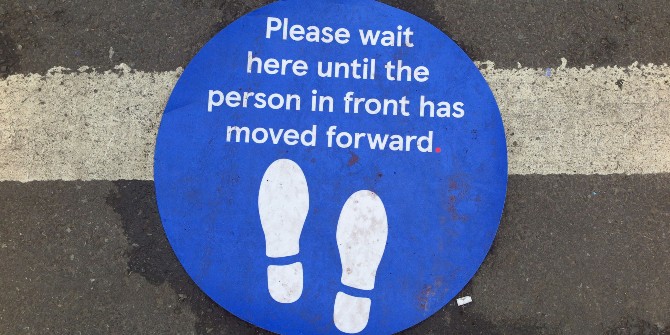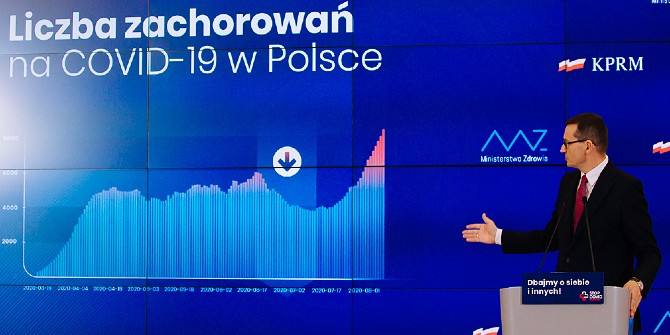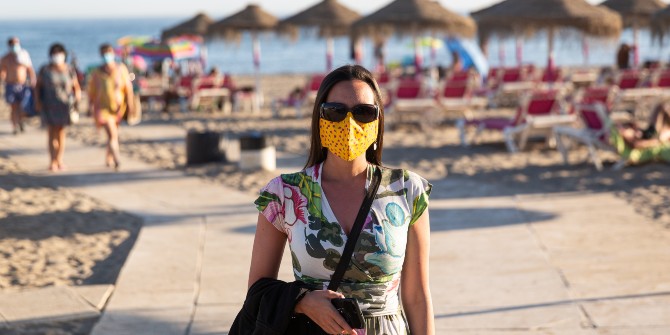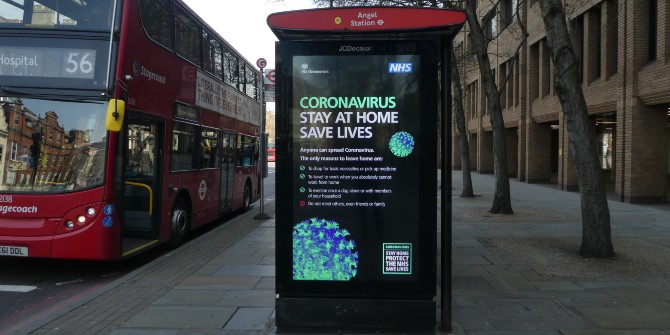In spring 2020, many countries imposed radical, urgent actions including lockdowns to protect their citizens’ health – but there was also a need to protect people from the worst of the ensuing economic storm. Academics at the LSE’s Centre for Economic Performance (CEP) responded with analysis and evidence-based policy recommendations. Helen Ward reports on 12 things we learnt about the economy during COVID, and how it can recover from the pandemic shock.
The pandemic sparked an economic shutdown unprecedented in its speed and scale – but that did not mean that the effects were wholly unpredictable. Initially economists found imaginative parallels that we could learn from whether these were student protests in Chile, home working at call centres in China or a government scheme to subsidise Italian firms that reduce workers’ hours during a crisis. Then, as real-time data from the pandemic became available, further research uncovered who needed help and how best to support them. What did we learn?
1. Shutting schools has an uneven impact on learning…
From the start of the pandemic, there were warnings that children from disadvantaged backgrounds would be affected more than others by shutdowns. In May 2020, Lee Elliot Major and Stephen Machin recommended a national tutoring service to help children catch up. In the UK, the gap between private school pupils and state school pupils was stark, with 74 per cent of private school pupils having full school days during the first lockdown compared to 38 per cent of state school pupils. By spring 2021, even after taking home learning into account, pupils had lost on average 61-66 days of learning (about a third of a school year).
2. … and the disadvantages in school were often multiplied by stresses at home
It was fathers and mothers who were already disadvantaged that were more likely to lose earnings, or their jobs, during the first wave of the pandemic. Both mothers and fathers who suffered unemployment also experienced poorer mental health.
3. Young people were also particularly hard hit by job losses
Young people aged 18-25 who were in work before the pandemic were almost three times as likely (16 per cent) to leave work between April 2020 and March 2021 than those aged 26 and over (6 per cent).
4. And the ongoing effects could mean Generation COVID’s fortunes are more closely tied to their start in life than ever
Social mobility looks likely to fall. Even once schools reopened and employment returned, negative education experiences and unemployment spells will create long-term “scarring” effects. The pandemic has magnified pre-crisis inequalities and, without action, children from the most disadvantaged families will find it increasingly hard to rise out of the income group into which they were born.
5. Traditional employment measures didn’t always capture people’s experiences of work (or lack of it)
The UK’s furlough scheme was designed to keep employees in work by subsidising their wages while businesses were closed. A new comprehensive employment rate measure designed by CEP researchers assessed the “realistic” employment rate, unseen by traditional measures. This found employment fell by more than 15 percentage points between February and June 2020 with the youngest, those with a lower level of qualifications, ethnic minority workers and those who were already low earners among the most susceptible to unemployment.
6. In the UK the newly self-employed found it particularly tough
The fortunes of self-employed workers varied widely depending on their sector – while delivery drivers were busy and facing health risks – others were not able to work at all. At the start of the crisis, more than a third of self-employed workers lacked money for basics and by November 2020 one in five of the self-employed anticipated leaving self-employment. In March 2021, researchers called for government support to be extended to newly self-employed workers. By September 2021, incomes were still below pre-crisis levels.
7. Working from home was not gender-biased, but the caring shift was
In previous UK recessions, men had been more likely to be made redundant than women. This time it was female-dominated jobs in retail and hospitality that were at risk. During the first lockdown men and women were equally likely to lose, or keep, their jobs. But it was women who were most likely to pick up the extra work involved with homeschooling and caring. While gender gaps in childcare and home-schooling widened on average, a sizeable minority (18 per cent) of households saw men became the main childcare provider – perhaps prompting an ongoing reversal of traditional gender roles.

8. While working from home looks set to become far more widespread post-pandemic …
Once set up, workers found they preferred to work at home for two or three days a week. Indeed, four in ten Americans who worked from home at least one day a week said they would be prepared to look for a new job if employers insisted on a five-day return to the worksite.
9. … this is unlikely to lead to cities being abandoned…
A rise in working from home may mean a drop in spending in major city centres, but it is unlikely to mean a wholesale exodus. The benefits of cities in terms of generating new ideas, transport links and socialising remain.
10. …but it does mean the drop in burglary rates could become permanent.
Acquisitive crimes – burglary, shoplifting, robbery – unsurprisingly fell while shops were shut and people stayed at home. But it seems that criminals shifted their attention to cybercrime.
As crime trends changed, domestic abuse became a particular concern – average rates looked to be unaffected by lockdowns, but deeper analysis revealed that attacks within the home had risen during lockdown, while offences by ex-partners had fallen.
11. Many firms also had to cope with the uncertainty around Brexit
By December 2020, firms said the uncertainty over the future UK-EU trading relationship was a greater hindrance to being able to prepare for Brexit than COVID.
12. And firms warned that the effects of COVID on business were lasting longer than expected
In early 2021, as the furlough scheme and business support schemes neared their deadline – more than 900,000 (1 in 7) UK small businesses warned they were at risk of failing by early April. The chancellor did extend furlough and other business support schemes, in the March 2021 budget.
Now an even greater challenge lies ahead: as the recovery from COVID and adjustment to Brexit continues, there is also a need to make sure that investments in jobs and innovation help the transition to net zero
Researchers have identified the existing comparative advantages the UK has in clean technology, saying building on these could entail a triple-win for UK policy makers: mitigating climate change, promoting economic growth and the levelling-up of economic prospects.
A focus on what works for wellbeing can help us make decisions that balance health, economic and social factors – not just for now, but for the long term
“Everyone wants to build back better – but what is better?” Richard Layard asked in his CEP 30th anniversary lecture. He explained the variation in wellbeing between countries, depends partly on income and health but importantly on social factors, especially freedom, corruption, trust, social support, generosity and peace. Using wellbeing as a common metric enables us to compare the impact of changes in these dimensions. “We are at a crucial moment: the coronavirus crisis has made us all rethink our priorities,” Layard said. “The key principle here must be the greatest wellbeing.”
This post represents the views of the author and not those of the COVID-19 blog, nor LSE.





